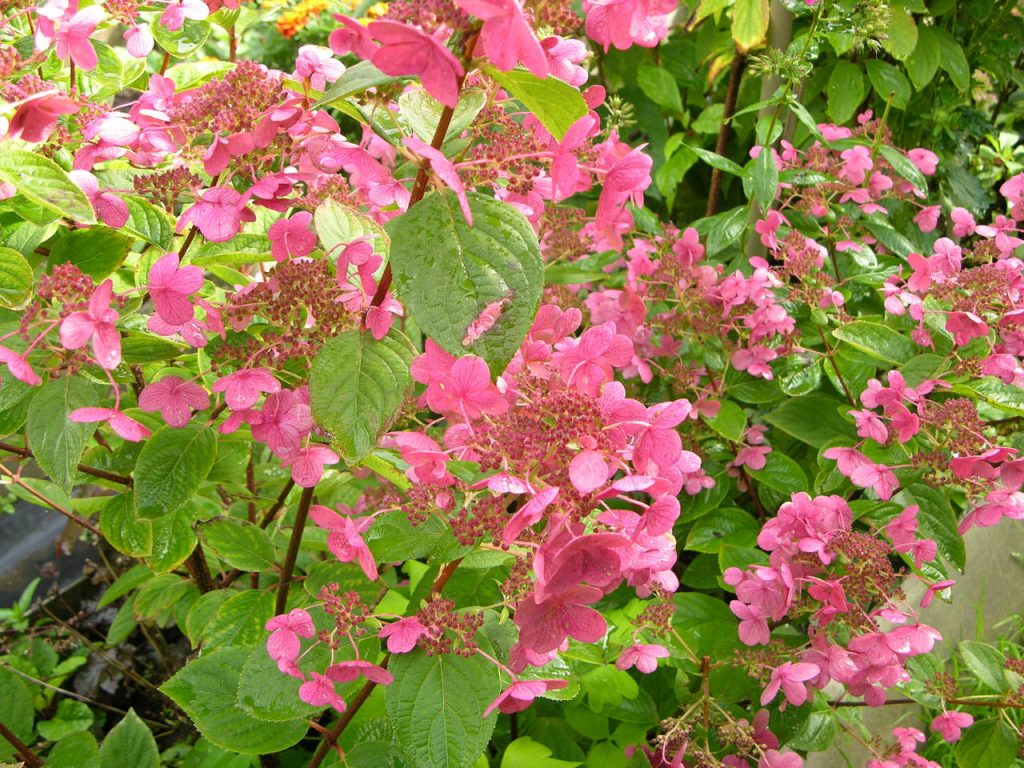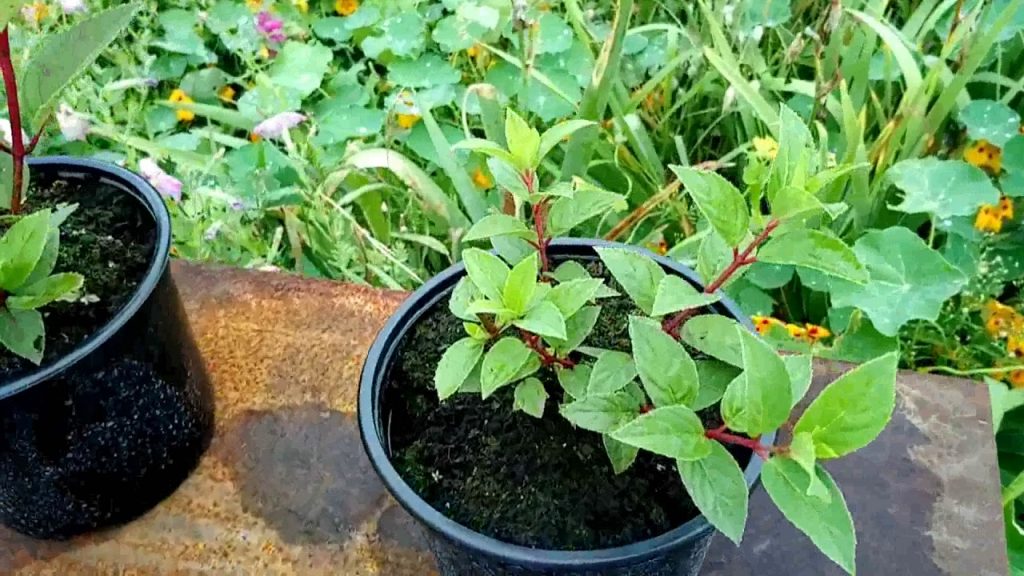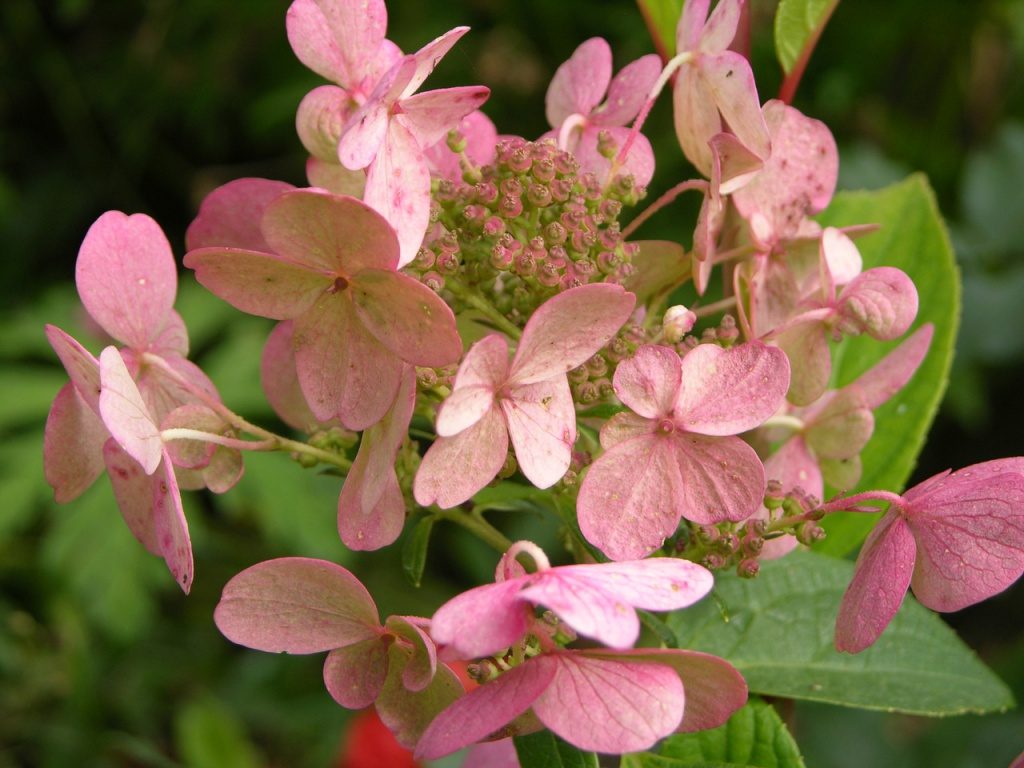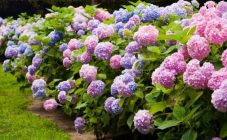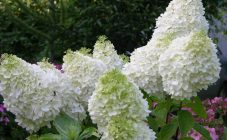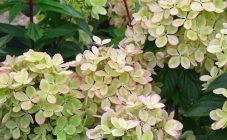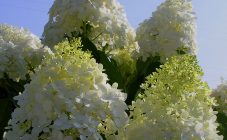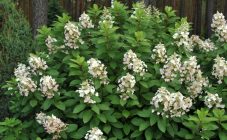Hydrangea is a perennial crop. We can say that this bush is a long-liver, under good conditions it can live up to 60 years. Hydrangea Early Senseishen is a deciduous decorative flowering shrub, a variety of numerous paniculate hydrangeas.
Description of the variety
The cultivar was found as a random seedling in a nursery among other hydrangeas in the Dutch city of Boskoop in 1991. In 2006 the cultivar received a patent and the name Bulk, and was chosen as the trade name Early Sensation. This extraordinarily beautiful lush hydrangea deserves the attention of amateurs and professionals.
A large-leaved bush of hydrangea paniculata Erly senseishen reaches 2 m. The leaves are dark green, serrated. Shoots are straight, purple. Forms inflorescences on the shoots of the past and current year. Characteristics of inflorescences: large racemose, up to 30 cm in diameter, diameter of individual flowers from 3 to 5 cm. At the peak of flowering, the inflorescence is almost completely hidden by the bush itself. The flowering period is long.
Inflorescences are broad-cone-shaped, consisting of pink sterile flowers and buds of fertile flowers, which open with creamy flowers, and then turn pink.
One of the features of the Erly Sensei hydrangea is the color change during the flowering period: first, the petals are creamy white, then deep pink, and closer to autumn they are purple.
Hydrangea Senseishen is frost-resistant. It is able to overwinter without special shelter, continuing its annual lush bloom. It can withstand up to -35 ˚С without losses. Even if some shoots freeze, the plant will quickly recover. Such winter hardiness makes the Erly hydrangea attractive for cultivation in many regions of Russia: the Leningrad region, the Novgorod region, the Moscow region, the Volga region (Penza, Saratov, Samara, Ulyanovsk, Volgograd and Astrakhan regions), the Urals.
The advantages of the variety:
- high decorative qualities;
- frost resistance;
- early and long flowering.
Landing
Hydrangea is propagated by seeds, cuttings, layering. When sowing seeds, you must follow the recommendations in the instructions.
When choosing a site for planting, it is necessary to take into account that the Early Sensation hydrangea is a very light-loving culture. Abundant lighting of the shrub contributes to its lush flowering. He dislikes drafts, so he will feel good against the wall of the house or near the fence. This arrangement will help protect the hydrangea from strong winds.
The root system is superficial, but branched. When planting, the root collar must not be buried. Panicle hydrangea grows well on soils with neutral or weak acidity. 1/3 of peat is added to the planting hole. To maintain the required moisture, you can add the soaked hydrogel. This is especially true in the absence of the ability to conduct timely watering. Mulching the trunk circle will allow you to maintain the necessary soil moisture. For hydrangeas, mulching is done with humus, peat or coniferous litter.
Care
Care for hydrangea paniculata consists in weeding, watering, feeding, pruning
Watering is carried out throughout the season at intervals of 1-2 times a week. It is especially necessary to monitor soil moisture when establishing dry weather.
Top dressing is carried out with full complex fertilization in the spring, as well as during the period of bud formation. To prepare for the cold weather, hydrangeas are fed with potassium-phosphorus fertilizers. They help to strengthen the root system of the plant. Loosening is carried out simultaneously with weeding to a depth of 5-6 cm and watering 2-3 times per season.
To preserve decorativeness and abundant flowering, it is recommended to carry out sanitary and rejuvenating pruning of the shrub. In the spring, even before the leaves appear, weak branches are removed, and the developed ones are cut off, leaving 2-3 pairs of buds. Young plants are not pruned, because crown formation occurs up to 4 years.
Pruning is also done in autumn. In this case, the shoots are shortened by 2/3. Pruning allows you to get strong shoots and more lush flowering, and also helps to preserve the plant during frost (short stems are less damaged by frost). Cut shoots root well and can be used as cuttings.
The effort put into growing and nursing is well worth the lush flowering of hydrangeas over the years. Landscape designers love to use hydrangea to create single lawn plantings, specimen groups, herbaceous and perennial mixborders. Unshaped hedges look great from it. This is a worthy decoration for any idea of a landscape designer.
Hydrangea Earli Senseiion blooms much earlier than other varieties. The caps of flowers look very interesting, which at the same time can have different colors. Early Sensation hydrangea, strewn with many bright inflorescences, always looks spectacular and pleases with its decorativeness all season. Cut flowers retain their freshness for a long time, they are often used to create spectacular bouquets.
Undoubtedly, the magnificent lush bloom of hydrangea will not leave anyone indifferent. Of all the varieties on the market today, Erly Senseis certainly deserves the attention of gardeners.
